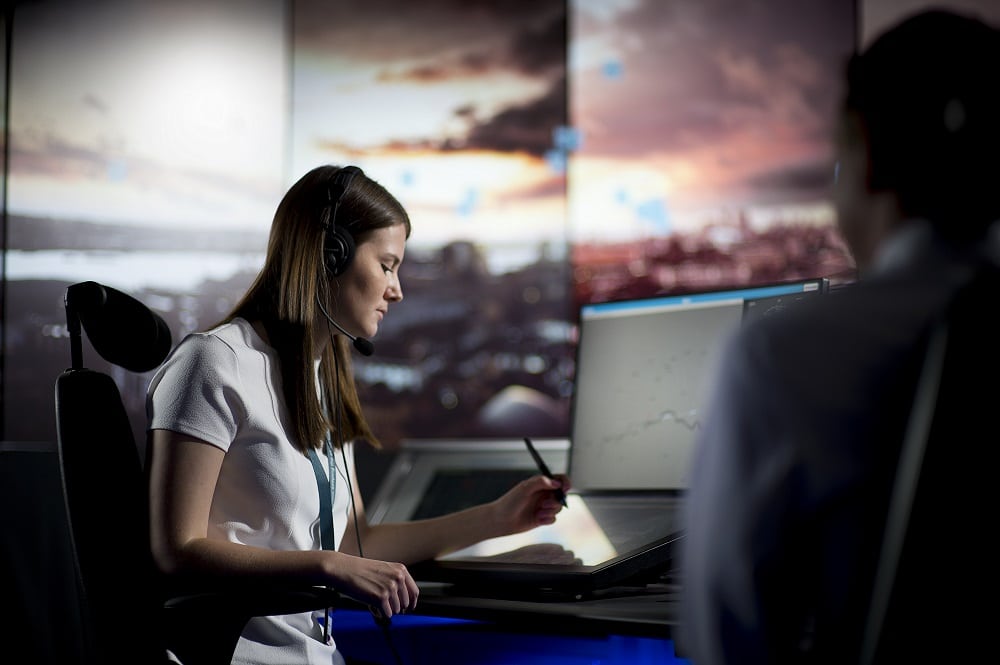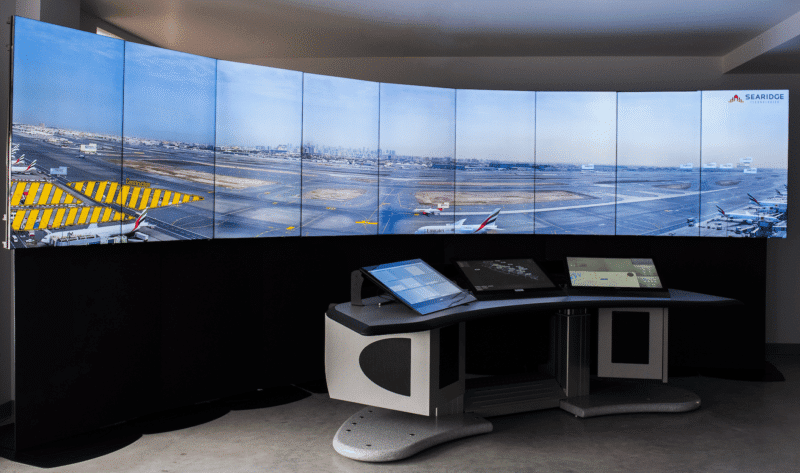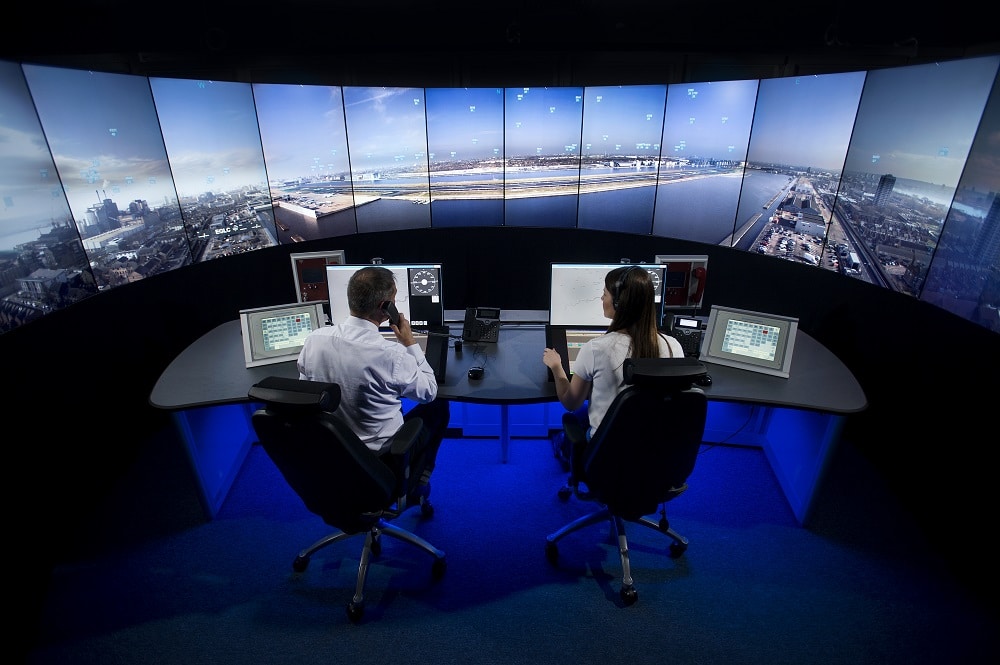Aviation
A London Airport Is Getting an Upgraded Air Traffic Control Tower-80 Miles Away From All the Planes

A London Airport Is Getting an Upgraded Air Traffic Control Tower-80 Miles Away From All the Planes
London’s City Airport is getting its high-tech upgrade in large part due to a lack of space. Instead of a bulky traditional tower that has to house actual humans, the new ATC tower will simply be host to a whole bunch of cameras, with live footage piped to controllers in a building some 18 miles away.
London’s City Airport is getting its high-tech upgrade in large part due to a lack of space. Instead of a bulky traditional tower that has to house actual humans, the new ATC tower will simply be host to a whole bunch of cameras, with live footage piped to controllers in a building some 18 miles away. There are additional benefits beside the saved space, too. The screens at the remote headquarters can compress a 360-degree view into 270 degrees, making it possible monitor more action in a smaller space
The airport is to decommission its traditional tower in 2019, meaning aircraft will be directed from a digital control room in Hampshire. Air traffic controllers will have a 360-degree, high definition view of the airfield, meaning they can monitor planes in more detail than by using the human eye, the airport said.
The technology has already been tested in Australia, Sweden, Norway and Ireland.
Current Situation –
The Tower Building Traditionally every airport has a conventional air traffic control tower, but they don’t come cheap. They cost millions to build and not all parts of the airfield are always visible. In comparison, going digital is more cost effective and offers real operational benefits.
A Digital Alternative
- Controllers use high definition cameras and remote sensing technology to safely and securely manage air traffic from a location away from the airport
- All operational data is transferred via a secure super-fast network to a custom built digital tower operations
room at NATS’ Swanwick air traffic control centre - Wrap around screens give the controllers an unparalleled view of the entire airport
The Technology
- High definition cameras provide a full 360 degree view of the airport
- Laser range finder for measuring distances to pin point accuracy
- Pan, tilt and zoom cameras to view any part of the airfield in unprecedented detail
- Displays enhanced with augmented reality style maps and aircraft data for increased controller awareness.
According NATS blogs Question and Answer.
How safe are digital control towers?
Everything is designed – from the technology to the procedures – with safety in mind and the same will apply for digital towers:
What happens if a camera fails?
In the system we’ll be using at London City Airport from 2019, there are 14 cameras, plus two separate ‘pan tilt zoom’ cameras. If one of the main cameras fails, one of the PTZs can quickly fill the gap until the camera can be swapped out and replaced.
What happens if all the cameras fail?
In the unlikely event that all the cameras fail, or that both of the independent video data feeds drop out, the team will revert to operating under Low Visibility Procedures as they do when in low cloud or fog, using voice communication and radar. This will slow things down, but it’s a normal part of ATC procedures and all very safe.
What about the screens?
There are 15 screens in the facility at Swanwick, meaning that if one of them fails the redundant one can instantly pick up the slack. The controllers can also rejig the order in which the screens display, meaning they will still see the airfield correctly. Then, at the right time, the defunct screen can be swapped out and replaced.
Can it be hacked?
Obviously we can never go into specifics about cyber security, but it is something we take incredibly seriously and keep under constant review. It is not an issue we ignore. What I can say it that the systems undergo extremely vigorous testing and for London City, we will have three entirely private and independent data feeds from the airport to Swanwick – two capable of carrying voice and video data, and the other just voice. 
Wouldn’t it be safer to be at the airport?
This is one I hear quite a lot and I always answer by turning the question around: could it not be safer and more resilient to have your ATC operation offsite? In any case the principle of controlling aircraft from a remote location isn’t new. Our radar controllers at Swanwick and Prestwick centres are looking after aircraft potentially hundreds of miles away and all without ever setting eyes on them.
Liked it ?
Share with your Friends and Family

Airlines
Air India to Launch aircraft maintenance training institute in Bengaluru

Air India, one of India’s leading global airlines, is set to establish a Basic Maintenance Training Organization (BMTO) in Bengaluru.
This institute will offer a comprehensive Aircraft Maintenance Engineering (AME) program certified by the Directorate General of Civil Aviation (DGCA). The program will follow an integrated 2+2 year structure, combining classroom learning with practical, hands-on training.
This initiative is part of Air India’s broader goal of creating a robust aviation ecosystem in India. With plans to expand its fleet and strengthen its operations, the airline aims to build a skilled workforce of maintenance engineers, making the organization self-reliant while supporting its ambitious transformation journey.
This country tops visa rejections in the popular Schengen countries
To bring this vision to life, air india has partnered with Bengaluru Airport City Limited (BACL), a subsidiary of Bangalore International Airport Limited (BIAL). Together, they will develop a state-of-the-art facility spanning 86,000 square feet at Bengaluru Airport City.
This purpose-built campus will feature modern classrooms, well-equipped laboratories, and qualified trainers to deliver world-class education and training. The institute is expected to become operational by mid-2026.
The BMTO will be located close to Air India’s new 12-bay Maintenance, Repair, and Overhaul (MRO) facility, also set to open in Bengaluru by early 2026. The AME program will begin with two years of academic coursework, followed by two years of practical training at the MRO, ensuring students receive hands-on experience adhering to industry standards.
Sanctions & Engine Issues Ground Half of Russia’s A320neo fleet
In the meantime, Air India has introduced a Cadet AME program in collaboration with reputable institutions in Bengaluru and Hyderabad.
This ensures continuity in its commitment to developing skilled aircraft maintenance engineers while the BMTO facility is under construction. The program also allows students to pursue a bachelor’s degree through university partnerships, enhancing their career and academic opportunities.
With this initiative, air india plane aims to address the growing demand for skilled professionals in aircraft maintenance and engineering, air india new planes contributing to the development of India’s aviation sector and creating specialized career paths for aspiring engineers.
-

 Aviation2 months ago
Aviation2 months agoMicrosoft Flight Simulator Raises $3 Million to Bring Back the An-225 Mriya
-

 Airlines2 months ago
Airlines2 months agoQatar Citizens Can Travel to the United States Without a Visa
-

 Aviation2 months ago
Aviation2 months agoQatar Airways bans these new Electronic Devices on plane
-

 Airlines2 months ago
Airlines2 months agoJapan Airlines Rolls Out Free Domestic Flights to International Passengers
-

 Defence2 months ago
Defence2 months agoWhich Country Has the Largest Fleet of Fighter Aircraft?
-

 Airport2 months ago
Airport2 months agoWestern Sydney Airport Welcomes Its First Plane After 6 Years of construction
-

 Travel2 months ago
Travel2 months agoQatar Airways Launches Four Additional Flights from Amsterdam
-

 Aviation2 months ago
Aviation2 months agoDid you know ? Once Boeing 747 carried 1088 passenger in 1991










